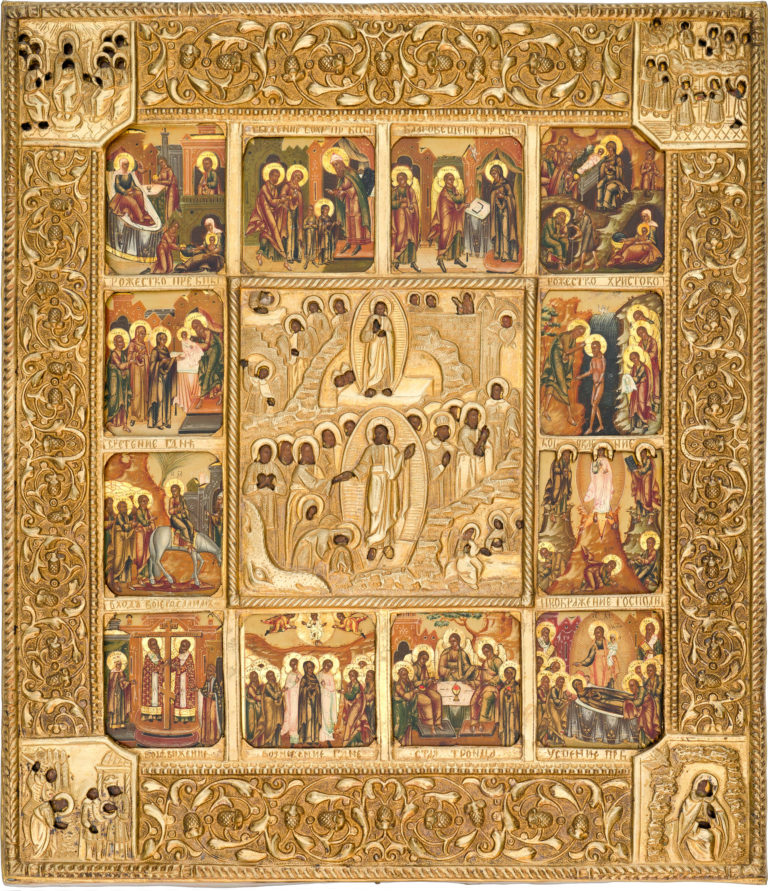The Resurrection—the Descent into Hell, with Church Feasts in 12 Border Scenes, Pentecost, the Pokrov, the Beheading of John the Baptist, and the Prophet Elias in the Desert
Antique Russian icon: last quarter of the 19th century. Religious icon painting centers of the Vladimir region.
Oklad cover: last quarter of the 19th century.
Size: 35 х 30 х 3 cm
Wood (two panels), two incut profiled support boards, a shallow incut centerpiece, underlying layer of canvas is not visible, gesso, tempera. Oklad cover: white metal, embossing, engraving, etching, silver-plating.
The paintwork is well preserved with only several remnants of the darkened varnish missed at restoration and small fallouts of gesso on the religious icon borders. The oklad cover is also very well preserved.
Contact us

The Resurrection—the Descent into Hell, with Church Feasts in 12 Border Scenes, Pentecost, the Pokrov, the Beheading of John the Baptist, and the Prophet Elias in the Desert
Diagram of the border scenes:
Diagram of the border scenes:
- The Nativity of the Mother of God;
- The Entrance of the Mother of God into the Temple;
- The Annunciation;
- The Nativity of Christ;
- Candlemas (The Meeting of Christ in the Temple);
- The Theophany (The Baptism of Christ);
- The Entrance into Jerusalem;
- The Transfiguration;
- The Elevation of the Holy Cross;
- The Ascension;
- The Old Testament Trinity;
- The Dormition of the Mother of God;
- Pentecost (The Descent of the Holy Spirit on the Apostles);
- The Pokrov (Feast of the Protective veil of the Mother of God);
- The Beheading of John the Baptist;
- The Prophet Elias in the Desert.
Eastern Orthodox Church icons of Feasts were especially popular among the faithful largely due to their practicality (a single hand-painted icon contained the main events of the liturgical year), which made such religious icon paintings a kind of the home’s small iconostasis.
In folk culture, these hand-painted Orthodox icons were seen as a sort of agricultural calendar, the cycle of which was clearly linked with the feasts of the liturgical year. The Nativity of the Mother of God (September 8th) was the day when bees had to be locked away, and onion had to be collected. The Elevation of the Holy Cross (September 14th) reminded about the coming of winter and the beginning of the harvesting period. The Feast of the Entrance of the Mother of God into the Temple (November 21st) was the day when winter came into its own, marking the beginning of the sleigh ride season. The Nativity of Christ (December 25th) was the main family feast, the celebration of which embraced several old, pre-Christian Slavonic traditions known as Svyatki. According to popular beliefs, river waters blessed at the Feast of the Theophany (January 6th) held special powers. This water was collected and used throughout the year to bless the home, farm, and livestock belonging to a family. Candlemas (February 2nd) symbolized the meeting of Winter and Spring. On that day, Russian peasants organized ritual fist-fights to help the incoming spring. Water blessed on Candlemas was also seen as especially sacred. On the Annunciation (March 25th), the peasants burned their old straw beds to prevent the return of the last year’s maladies. Crumbs of the prosphora (holy bread) received on that day were preserved and placed in the ground with the seed grain. Pussy willow branches – blessed in Russia instead of palms during the Entrance into Jerusalem Feast – were used for healing the sick. On the Ascension, the Russians boiled eggs and made pies and pancakes that were taken to the procession across the fields by the villagers asking for a good harvest. Pentecost or the Holy Trinity Feast (the 50th day after Pascha) was the time of the rebirth of the land and forests. On that day, churches and homes were decorated with green tree branches and flowers – as the symbols of Eternal Life. On the Transfiguration (August 6th), ripe apples and fruits were brought to the church and blessed; this was followed by the blessings of the fields with holy water. The evening of the Transfiguration marked the last farewell to the Summer sun and the meeting of Autumn. The Dormition of the Mother of God (August 15th) marked the end of the harvest season when priests blessed the harvested crops in churches. This was seen as the best time for the sowing the late seeds. The Beheading of John the Baptist ended the summer and began the Autumn season. It was the day of strict fasting, with the villagers abstaining from all round types of food, as well as from dancing and singing, remembering the cruelty of Salome.
The stylistic characteristics of the given antique Russian icon, especially its dark color pallet, the olive-brown color of the borders, and the dry gold hatching of the vestments, all attest to the fact that this piece of Eastern Orthodox Church icons was painted in the late 19th century. Instead of the traditional depictions of the Four Evangelists usually seen in the corners of such religious icon paintings, this antique Russian icon includes other Feasts (Pentecost, the Pokrov, the Beheading of John the Baptist, the Prophet Elias in the Desert) that expand the Festive cycle and give the religious icon a more universal character.
The embossed oklad frame brings more structure to the given hand-painted Orthodox icon. The complex, floral ornamentation on the religious icon borders imitates the 17th-century silverwork: the vines take a spiral shape, and all floral texture is brilliantly executed by the silversmith. Such ornamentation was widespread among ecclesiastic silversmiths in the 1860s and endured until the end of the 19th century.
This beautiful piece of antique Russian icons is definitely a worthy addition to any religious icon collection.